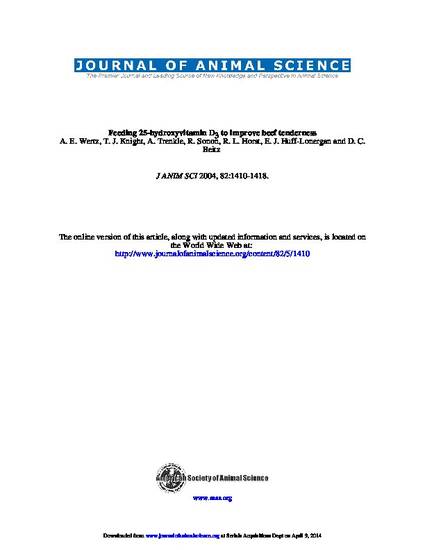
The objective of this trial was to determine if a single oral bolus of 25-hydroxyvitamin D3 (25-OH D3) given at various times before slaughter would enhance the tenderness of beef loin steaks. One hundred eight crossbred steers were allotted to 18 pens so that the mean weight of the cattle in each pen was similar. Treatments (25-OH D3 dose [62.5 or 125 mg]) and time of administration of the single oral bolus (4, 7, 21, or 35 d before slaughter) were assigned randomly to each pen of steers. Serial plasma samples were collected at each bolus administration time for control animals. For steers assigned to a treatment group, a baseline blood sample was collected before bolus administration and at each subsequent administration when other treatment groups received their bolus. Plasma samples were assayed for 25-OH D3 and calcium concentrations. Troponin-T degradation and Warner-Bratzler shear force were measured as indicators of tenderness for loin steaks collected at slaughter and aged for 6 or 14 d postmortem. Muscle samples, collected concurrently, were assayed for 25-OH D3 and calcium concentrations. A single oral bolus of 25-OH D3 was sufficient to increase plasma 25-OH D3 concentrations (P < 0.001) through slaughter, regardless of dose or time of bolus administration. The single oral bolus of 25-OH D3, however, did not increase plasma calcium concentrations (P > 0.05). As a result, neither troponin-T degradation nor Warner-Bratzler shear force was improved (P > 0.05) by treatment. Muscle 25-OH D3 concentrations were increased (P > 0.001) by treatment with 25-OH D3. Although sustained plasma 25-OH D3 concentrations did not increase plasma or muscle calcium at slaughter nor influence tenderness, the use of 25-OH D3 as a nutritional means of improving beef tenderness is in its infancy, and more research to delineate an effective dose and the potential interaction of seasonal exposure to ultraviolet light is warranted.
Available at: http://works.bepress.com/elisabeth_huff-lonergan/18/

This article is from Journal of Animal Science 82 (2004): 1410–1418.